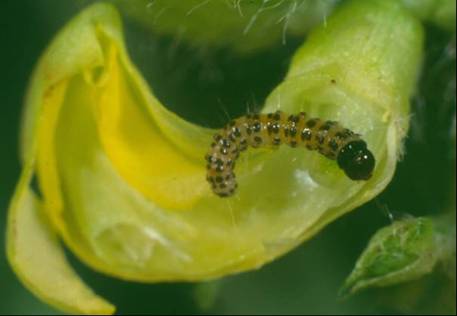Severe and sustained bean podborer (Maruca vitrata) outbreaks were widely reported in mungbeans over the past 2 summers.. Populations in excess of 100 larvae per square metre were observed in many crops. If left uncontrolled such populations not only impact on crop yield by reducing pod set, they also severely damage the pods that are set and delay harvest maturity.
Bean podborer (BPB) larvae feed initially inside buds and flowers, before attacking pods. The basic management strategy therefore is to control larvae before they leave the flowers to bore into the pods.
Severe bean podborer damage. Note webbing around flowering racemes and eaten out buds.
Podborers are normally a major coastal/subcoastal mungbean pest, but last year, damaging numbers were reported as far west as Surat on the western Darling Downs. Podborer pressure was so severe in some areas that a number of crops were sprayed 3-4 times. This repeated spraying also raised questions about pesticide efficacy against this pest. In response to industry concerns, DAFF initiated a series of trials in 2011 and 2012 to evaluate a number of pesticide options, including pesticides registered in mungbeans, but not necessarily against bean podborer.
Chemicals tested against podborer included; methomyl (Electra), indoxacarb (Steward EC) and the synthetic pyrethroids deltamethrin (Ballistic) and alpha-cypermethrin (Alpha-scud). All insecticides were applied with an air-assisted boom ground rig, with a spray volume of 100L/ha.
Podborer larvae numbers were assessed post treatment by:
· Beat sheet sampling (4 x 1m per plot), and by
· Dissecting flowers and buds from randomly picked raceme samples, 30 racemes per plot in the 2011 trail, and 50 per plot in the 2012 trial.
Raceme data gave a much clearer indication of the numbers of podborers actually present within the crop than the beat sheet sampling. Beat sheet sampling only detected 1/7th of podborer larvae present. So what does this mean for sampling for podborer?
Monitor for podborer
The first sign of an impending infestation are the distinctive moths which fly away when disturbed as you walk through the crop. The first visible sign of damage is the webbing of flowers and buds. However in the very early stages of an infestation, small larvae are out of sight inside buds and flowers with no external evidence of their presence. Infested pods have a well-defined entry hole (mostly one per larva), usually ringed with distinctive frass (caterpillar poo).
The most reliable way to assess podborer activity is to open up buds and flowers from as many racemes as possible (from at least random flowering 30 racemes across a crop). Divide the total number of BPB detected by the number of racemes sampled, and multiply by the estimated number of racemes per square metre.
If beat sheets are used for the monitoring of podborer – keep in mind that this method only detects about 14% (one seventh) of the BPB present.
Bean podborer in mungbean flower
Insecticide trial outcomes:
Based on 2 years of trial results, methomyl (Electra) and indoxacarb (Steward EC) gave good control of bean podborer in flowering/podding mungbeans. However insecticides must be applied before podborers become entrenched in pods. Good spray coverage is also vital. Synthetic pyrethroids performed poorly in the trials.
Data from these trials helped secure emergency use permits for both methomyl (PER 13426) and indoxacarb (PER 13435) against bean podborer in last season’s mungbean crops. Please note that these permits expired on 31 May 2012. Applications to have these permits re-activated next season are currently being submitted.
For more information about the bean podborer trials, please contact Hugh Brier
Article by Hugh Brier

